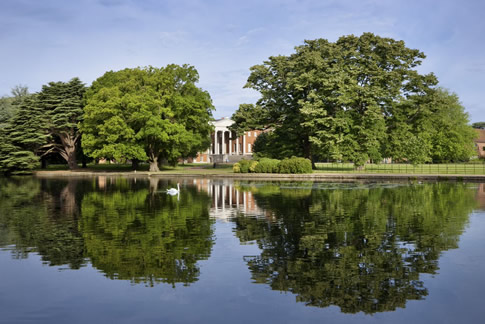
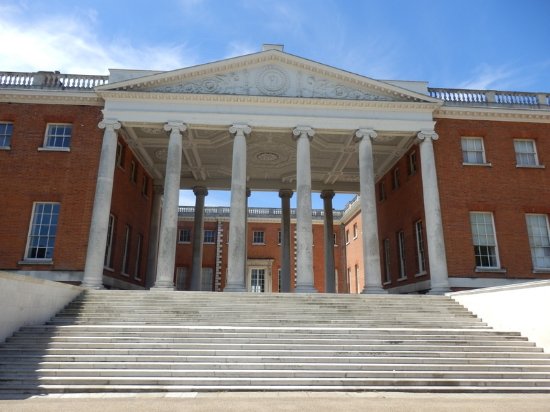
The elegant portico opens up the courtyard.

The 5th Earl of Jersey (1773-1859) became the owner of Osterley Park by way of his marriage to Robert Child’s granddaughter, Sarah Sophia Fane, the Lady Jersey who was a patroness of Almack’s. The story of the young heiress is well known, the second elopement of a Child female.
Robert Child’s daughter (Sarah Anne Child) had eloped with John Fane, later 10th Earl of Westmorland, in 1782. Robert Child (1739-82), proud of being a prince of the merchant class and not an aristocrat, did not want his property and fortune to go to the Westmorland family. He wrote a will which left his money and property to the second child of his daughter. Sarah Sophia Fane inherited everything at age eight. In 1804, she married George Villiers, who changed his name (a necessity under Child’s will) to Child-Villiers and in time became the 5th Earl of Jersey. He was the son of that Countess of Jersey who was a mistress of the Prince Regent.
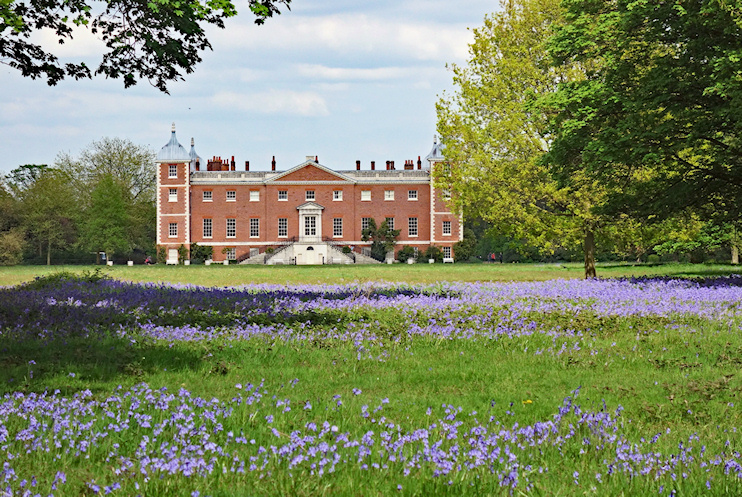
The Osterley house was rarely used by the Jerseys, who had a country estate, Middleton, in Oxfordshire in addition to a large townhouse in Berkeley Square. For decades Osterley was maintained but empty of life. The Jerseys entertained there only occassionally. Eventually it was let to Sarah’s cousin, Grace Caroline, dowager Duchess of Cleveland, a daughter of the 9th Earl of Westmorland. When she died, the 7th Earl of Jersey and his wife Margaret (1849-1945) lived and entertained there. The Lesson of the Master, a novella by Henry James, is set at Osterley.
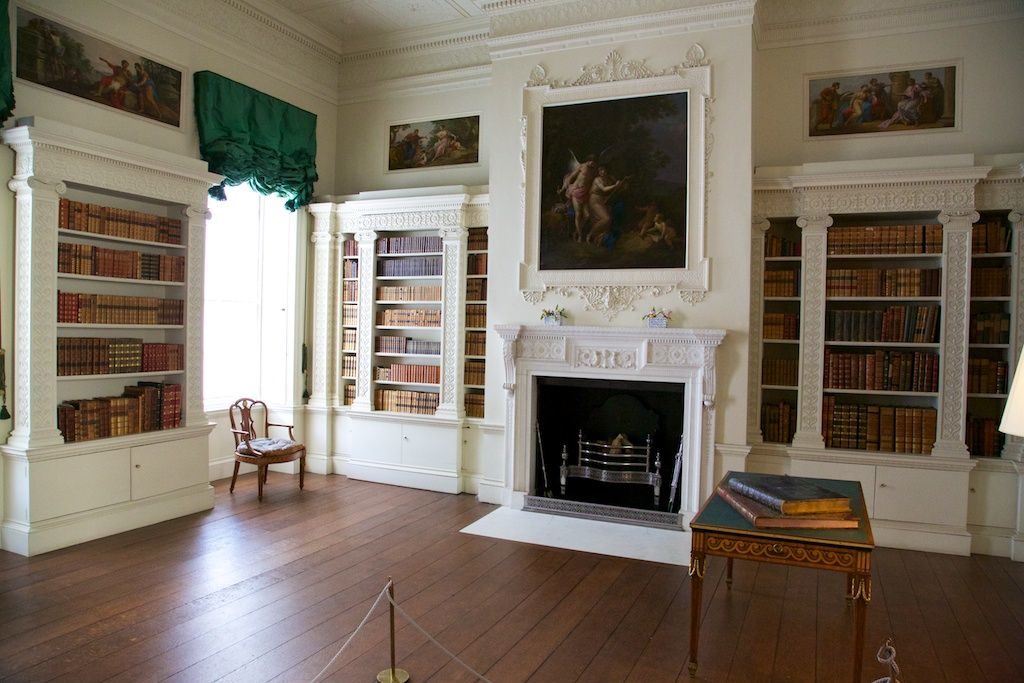
In 1885, the famous library was sold for thirteen thousand pounds. After the 7th earl died in 1915, the tenancy of the house foundered again. For many years, it was rarely used until the 9th Earl opened it to the public on weekends. He gave it to the National Trust in 1949 and considerable restoration has taken place. It was recently used for some scenes in the film Gulliver’s Travels and has been in numerous other movies and television productions.
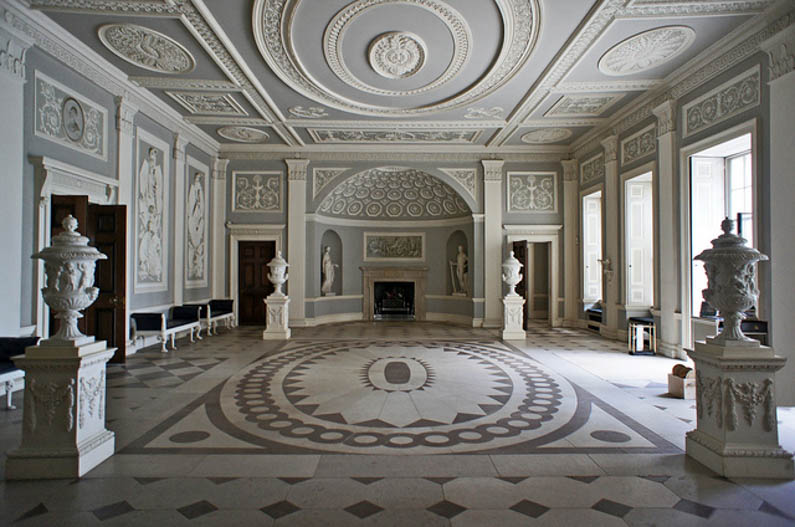
The rooms are arranged in a horseshoe, with the entrance hall at the top. After walking through the exterior portico, one crosses the courtyard and enters the magnificent hall, designed by Adam in 1767. The color scheme is neutral, greys and whites with stucco panels of ancient military scenes on the walls. The floor has a black pattern on white marble, a reflection of the plasterwork ceiling design.
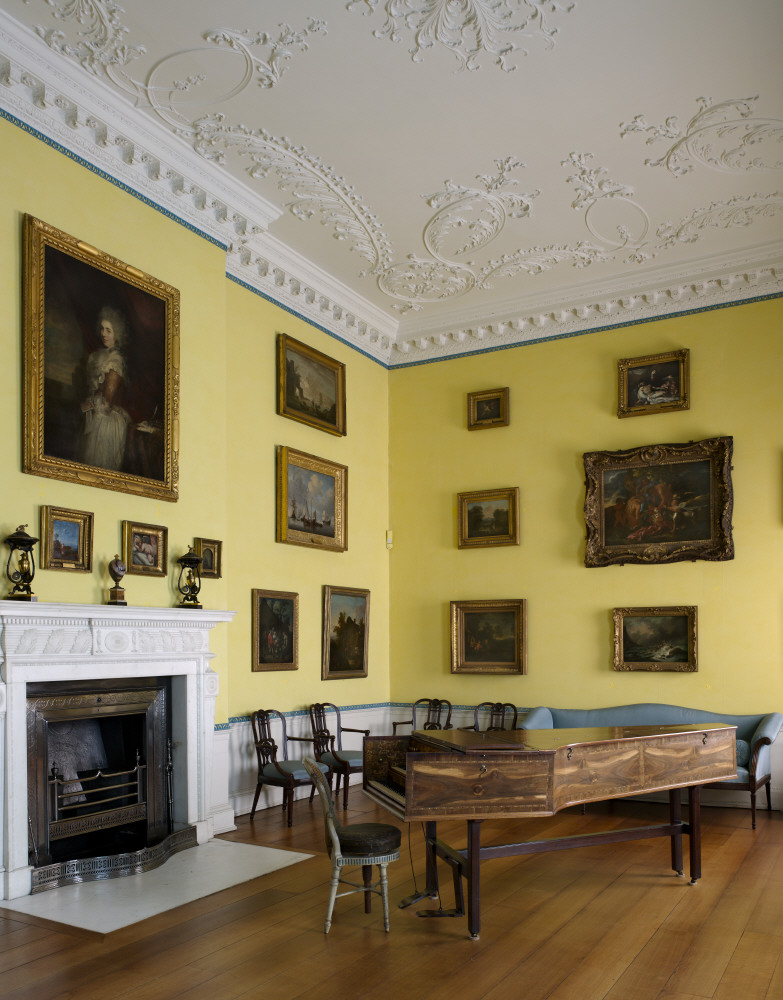
The Breakfast Room at Osterley Park, Middlesex. The harpsichord was made for Sarah Anne Child in 1781 by Jacob Kirckman and his nephew Abraham. The lyre-back chairs are attributed to John Linnell.
The Breakfast Room has a lovely view of the park and was used as a sitting room, graced by Adam’s arched pier glasses. This room was redone in the 19th century, but the colors and some furniture is to Adam’s design. The drawing for this design is in Sir John Soane’s museum, London, as are many Adam designs. It is dated 24 April 1777. The room also contains a harpsichord of 1781, made by Jacob Kirckman and his nephew Abraham, who were well known for their instruments. It belonged to Sarah Sophia’s mother, the countess of Westmorland. After her death in 1793, her husband asked to have it sent to him as a memento of his wife; it was returned to Osterley in 1805.
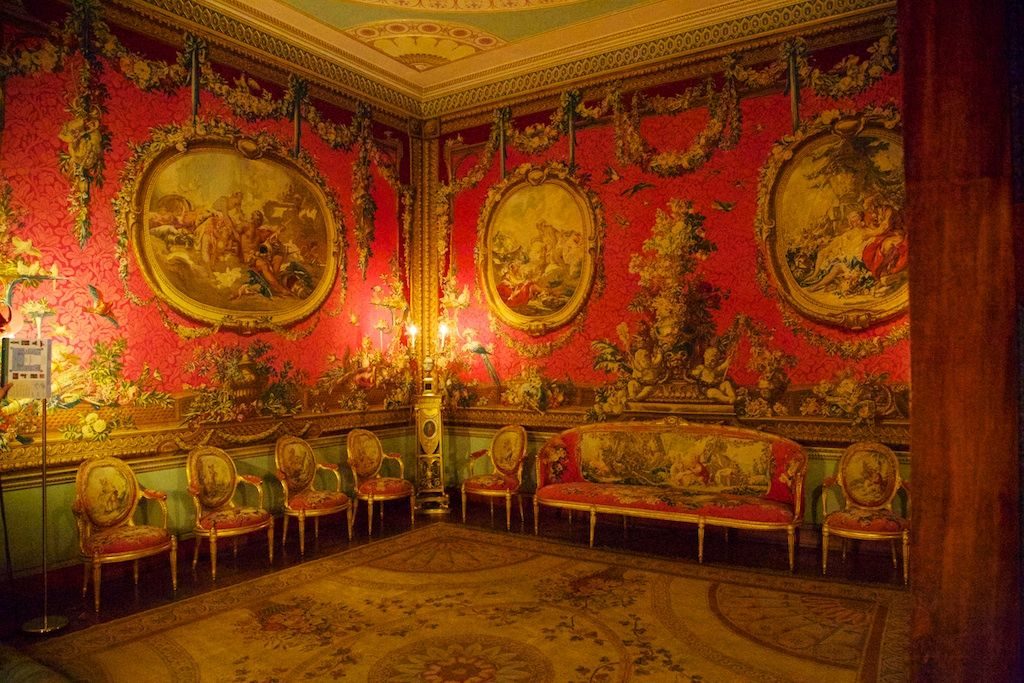
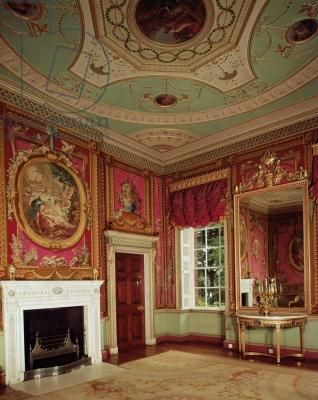
The magnificent ceiling is another Adam masterpiece. The central medallion shows Minerva accepting the dedication of a child. The four smaller medallions show female representations of the liberal arts. As was the usual practice, these paintings were done on paper, affixed to canvas backing and placed in stucco frames after the ceiling was painted.
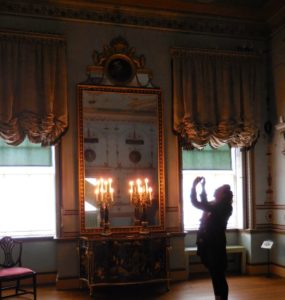
A self portrait by Angelica Kauffman. She did many paintings for Adam, often in her well-known allegorical style. In an era when most of the artists were men, Kauffman (1741-1807) excelled at portraiture and even huge historical and allegorical paintings. Born in Switzerland, she found great success in England. In 1781, she married her colleague Antonio Zucchi (1726-95) and the couple went to live in Rome. Adam had met Zucchi in Rome and persuaded him to come to England in 1766. Zucchi also executed many paintings for Adam rooms, often in ceiling medallions or above doors and fireplaces.
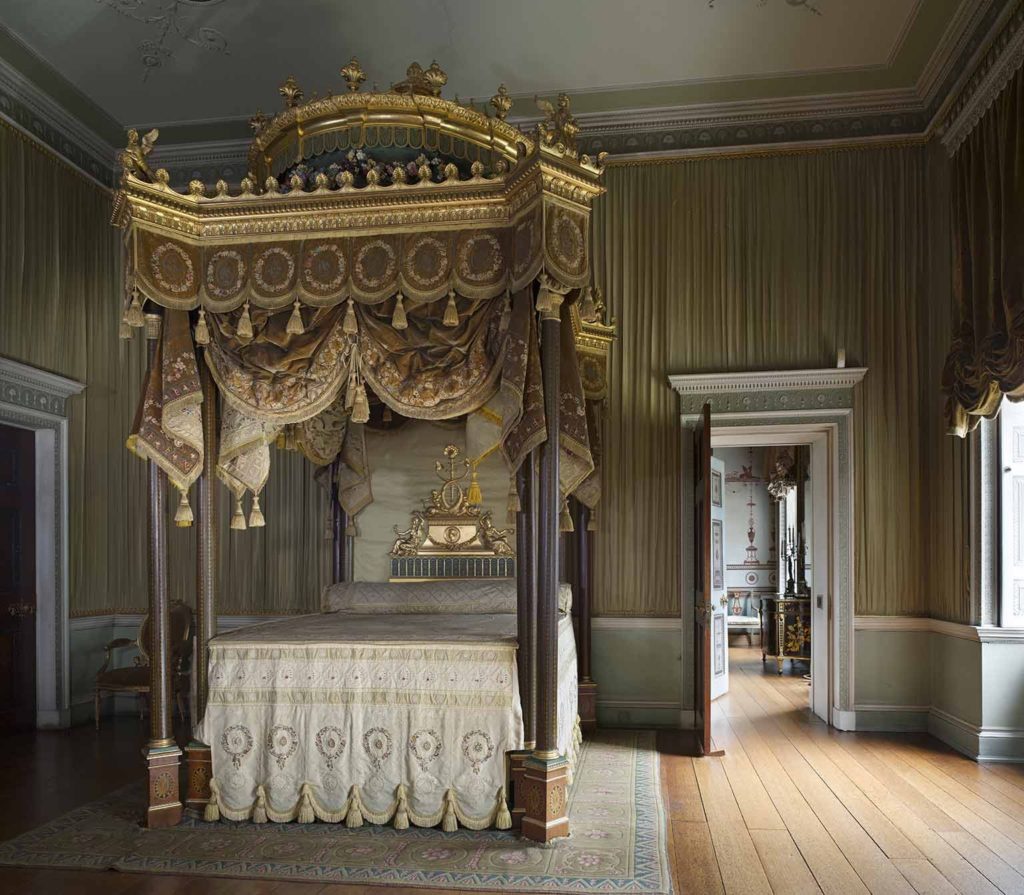
In the State Bedchamber stands a huge bed, made to the Adam’s design in 1776. The drawing is also in the Soane museum. Not only did Adam design the bed, he designed the hangings and embroidered silk counterpane and the interior of the dome. Included in the design are many allegorical symbols, including marigolds, the emblem of Child’s Bank. In this room is another of the exquisite ceilings by Kauffman.




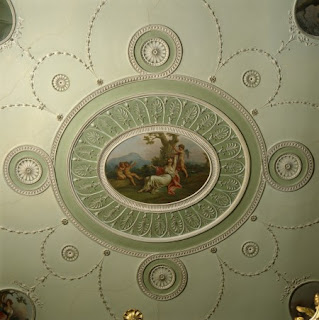
I almost posted yesterday how Osterly was one of my favorite houses to see Adams!
Lovely house! So many amazing sights!
My husband and I have been to London quite a bit and try and get off the beaten path a bit. A few years ago we were there for a few days in July on our way to Ibiza. I came up with a few places to easily get ourselves out of central London and Osterly Park was one place we went. Despite being under the flight path for Heathrow we had a wonderful time snoozing in the grass under an enormous tree behind the house. The weather was perfect I could have laid there all day. Of course the house was interesting too but it is the snooze on the lawn that I will remember. And I think there is a used bookshop between the Tube station and the Park. So not a bad day out.
A used bookstore — besides visiting stately homes and museums, I LOVE old bookstores. You definitely found more than one jewel that day!
This is not far from my daughter's home in West London, and she sometimes shops at that nearby Tesco's, so have been there many times with the grandkids. There is a fresh produce market on the grounds at certain times. The horses on the grounds are lively and there are always lots of fowl (ducks, swans, etc.) on the ponds.
The last time I saw it I was a bit concerned that it did not look so clean, but maybe housekeeping had a day off! It's a great place 🙂
Incredible post! Gorgeous house. Breaks my heart that the library was sold. What an asset it would be now the house is restored. And I LOVE Adams' work!
Osterley was the first Great House I saw in England and I still marvel at how beautiful it is!!!
Useful blog website, keep me personally through searching it, I am seriously interested to find out another recommendation of it.
A lovely blog on my family's old home. However I'm quite surprised that given the site is called Number 1 London and you have a picture of the Duke of Wellington you failed to mention that he and Sarah Sophia were great friends and that he was godfather to her daughters!
Lovely to see many people enjoying Osterley
Lord Jersey.
My Lord – Though we failed to make the Wellington Connection in the Osterly Park post, we do mention the Ladies Jersey quite often, and we thank you for taking the time to send your compliments. We would also welcome the opportunity to do more blogs on your family. Should you be interested in discussing these, please email us using the link on this page. We have mentioned some others of the Duke's godchildren in previous posts, which begs the question – just how many did he have!?
Great interior works. Especially the ceiling.